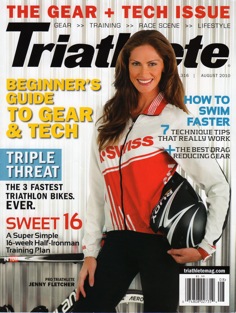Free Radicals and Antioxidants:
What They Mean for Triathletes
By Roy Stevenson

Triathlons have dozens of health benefits, ranging from weight control and stress reduction, to reducing cholesterol. These are, I’m sure, some of the reasons that motivate us to get out there to run and cycle on the roads and trails, and swim in the pools day in and day out.
Ironically, there’s also a down side to all this strenuous aerobic activity. The huge amounts of oxygen we process during triathlon training and competition cause increased oxidative stress to our body’s cells. This process, called oxidation, damages the muscle cell’s membrane, internal structure and organelles, impairing their function, causing inflammation, muscle soreness and fatigue—all caused by some nasty little molecules called free radicals. Other causes of free radical damage include stress hormones that are released when we exercise, pollution, exhaust fumes and heat.
However, certain nutrients called antioxidants neutralize the free radical damage by checking their rapid spread and removing them from circulation before they can do harm. Antioxidants are essentially a clean up crew of scavengers, sweeping free radicals away and blocking their formation.
All is well with our body as long as antioxidants outnumber free radicals. However, if we don’t consume enough antioxidants in our diet, and because we metabolize large amounts of oxygen while swimming, cycling and running, our antioxidant levels tend to quickly run low in our body. Evidence exists that antioxidants reduce free radical damage in endurance athletes.
Some research on athletes who take antioxidant supplements or eat lots of antioxidants in their diet have less muscle soreness and free radical production than those with low antioxidant intakes. Other research shows no buffering effect of antioxidant supplements on free radical activity. This conflicting research is most likely due to the individuality and nutrient status of the human subjects and how the antioxidants were administered.
However, many studies look promising enough to support the practice of eating antioxidants rich foods in our diet. Foods with high antioxidant content are extremely beneficial to our health, and eating large amounts of them can do no harm.
Whole Foods Antioxidants versus Supplements
Nutritionists would prefer that you get antioxidants from whole food sources instead of supplements, for good reason. Whole foods have a large number of antioxidants, plus other vitamins, minerals and fiber—and they’re a lot cheaper than supplements. However, many nutritionists and coaches recommend antioxidant supplements for heavy training endurance athletes. Kyle Heffner, MS, in his chapter, “Fortifying and Supplementing Your Energy Needs’, in Run Strong says, “There is growing evidence for the addition of antioxidants, or foods rich in antioxidants, to the diet. . . . Solid evidence supports the contribution of the following supplements to general well being: Vitamins C, E, and A; bioflavonoids. .”
Furthermore, antioxidant levels needed to combat free radical levels in hard training triathletes may be many times higher than can be supplied in food, so a supplement may also be necessary. For example, vitamin C (a strong antioxidant) needs of a hard training runner is likely to be many times the vitamin C requirements of a non-runner. With the vitamin C content of one orange being about 75 milligrams, an athlete may need up to 2000 milligrams or 26 oranges to compensate for free radical activity.
Where can we find Antioxidants in Foods
Where do We Find Antioxidants? Most are found in fruits and vegetables. Sports nutritionists suggest that a combination of fruit and vegetables have a synergistic effect on antioxidants.
Triathletes certainly have nothing to lose by increasing their intake of these wonder foods. Making sure you are eating enough of these antioxidants and phytochemicals may be the path to ensuring you recover from your training efforts efficiently, and perhaps staving off disease.
Table of Common Sources of Antioxidant Vitamins and Minerals
| Antioxidant | Common Food Sources | Antioxidant Properties | Dietary Reference Intake |
| Beta-Carotene | Cantaloupe, orange fruits & vegetables (carrots, sweet potatoes), leafy green veges (broccoli, spinach) | Reduces free radical production from exercise and protects against muscle cell damage from free radicals. | 2,500 IU daily (one large carrot) |
| Vitamin C | Green leafy vegetables, green peppers, raw cabbage, citrus fruits and juices, cantaloupe, berries | Reduces exercise-induced free radical damage, protects muscle tissue from damage | Upper limit 2,000 mg/daily |
| Vitamin E | Raw wheat germ, mixed nuts, seeds, sunflower seeds, fish liver oils, polyunsaturated vegetable oils | Helps with cell respiration, scavenges for free radicals during exercise, protective effect against free radical muscle cell damage, helps with immune function and DNA repair. | Upper limit 1,000 mg daily |
| Selenium | Whole grain cereals, egg yolk, milk, chicken, seafood, broccoli, garlic, onions, cereal bran, Brazil nuts, whole grain cereals, meats, tuna, plant foods. | Helps activate glutathione peroxidase enzyme, protective effect against cellular damage from free radicals | 400 mcg daily |
| Copper | Whole grains, shellfish, eggs, almonds, leafy green vegetables, beans | Helps produce antioxidant enzyme superoxide dismutase | 10,000 mcg daily |
| Manganese | Whole grains, egg yolks, dried peas and beans, leafy green vegetables | Helps use superoxide dismutase | Women 2.6 mg/daily; men 2.3 mg/daily |
Return from Free Radicals to Triathlons & Multisport
Return from Free Radicals to Home Page